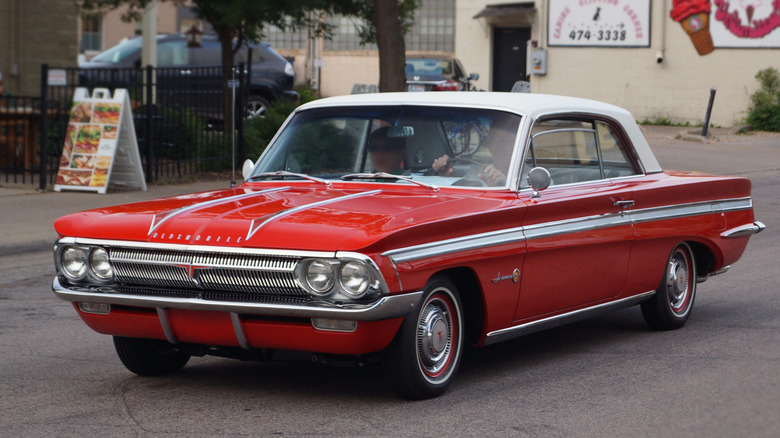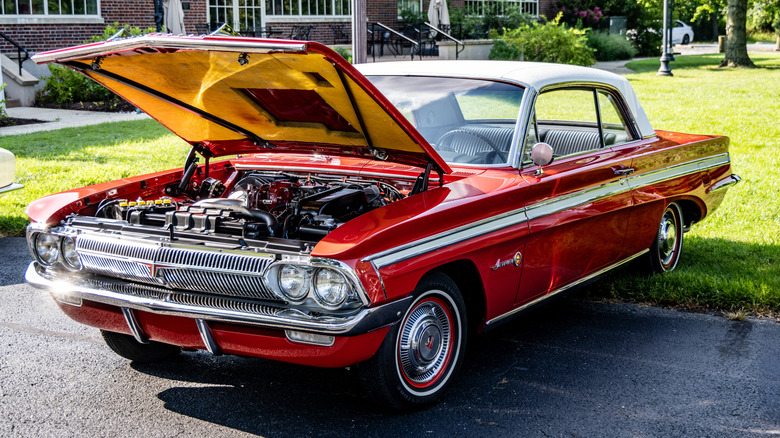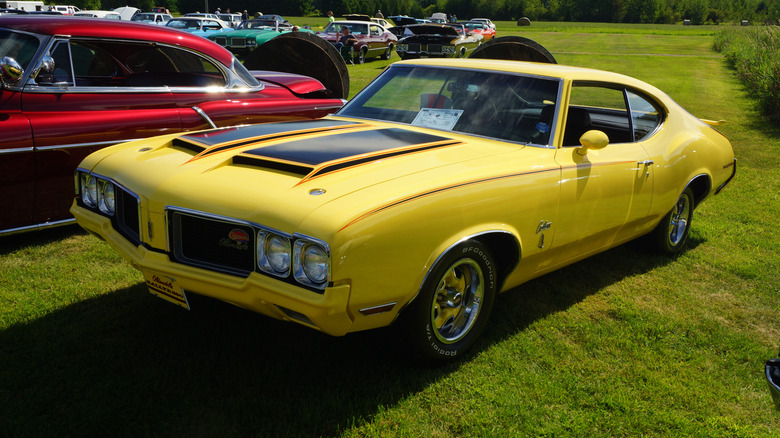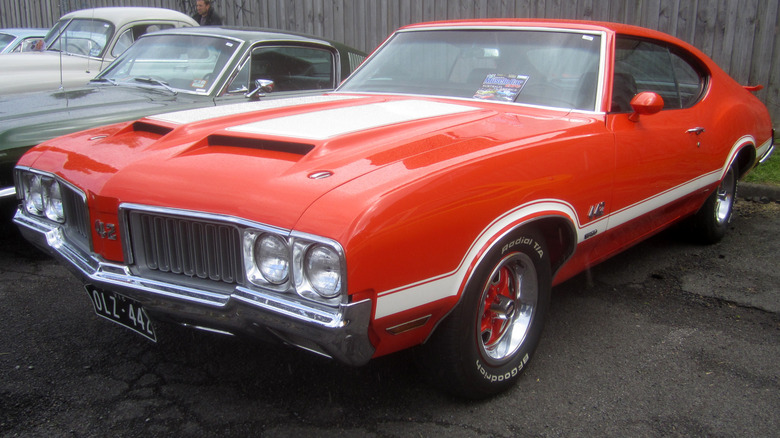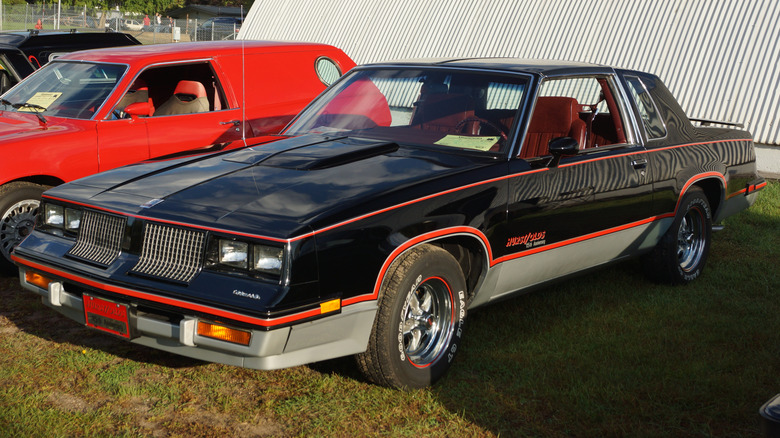5 Of The Most Underrated Oldsmobile Muscle Cars
While General Motors has discontinued many car brands over the years, few had the history and structure of Oldsmobile. From its origins as the Olds Motor Company in 1897 until its demise in 2004, the Oldsmobile brand was known for innovations such as the Hydra-Matic, the world's first mass-produced automatic transmission, which it introduced in 1940. It was also a trailblazer in engine design and safety technology. The first car to use airbags was an Oldsmobile, too.
This trailblazing history extended under the hood. The 1949 Oldsmobile 88 featured the overhead-valve Rocket V8 that produced 135 horsepower, an impressive output for its era. More importantly, that big, powerful V8 was installed in a relatively lightweight body, leading some experts to declare the Oldsmobile 88 as one of the first muscle cars ever made. In 1950, Oldsmobile went on to dominate NASCAR and win the Carrera Panamericana, firmly establishing itself as a high-performance brand.
The 1960s and 1970s saw some very famous Oldsmobile muscle cars, such as the 4-4-2, which is pronounced four-four-two. The name refers to the car's four-barrel carb, four-speed transmission, and dual exhaust pipes. What started as an option package for Cutlasses and F-85s in 1964 became its own model in 1968, complete with a Hurst/Olds package that included a Hurst shifter and other upgrades. However, the fame of the Rocket 88, the 4-4-2, and the Hurst/Olds can obscure the fact that Oldsmobile built several other muscle cars that are worthy of remembrance.
1962-1963 Oldsmobile Jetfire
Turbocharged engines were invented in 1915, but they remained relegated to ships, aircraft, and heavy diesel equipment until 1962. That was the year that Oldsmobile F-85's strange engine debuted as the Turbo Rocket V8 in a special model of the F-85 called the Jetfire. The Jetfire's cousin from Chevrolet, the Corvair Monza Spyder, also featured a turbocharged engine that year, making these two GM models the first production cars in the world to offer turbos. Turbochargers are common now, but in 1962, this was a radical new performance technology.
The Jetfire's Turbo Rocket was an aluminum 215-cubic-inch V8 with a Garrett AiResearch turbo bolted on. This boosted the horsepower to 215 and torque to 300 lb-ft, both of which were substantial increases from the naturally-aspirated version of the engine, which produced 185 horsepower and 230 lb-ft of torque. With its turbo power reaching the drive wheels through either a four-speed manual transmission or GM's Roto-Hydramatic, the Jetfire could reach 60 mph in as little as 8 seconds.
The Jetfire was an exception to the muscle-car era's well-known adage of there being no replacement for displacement, using technology rather than sheer engine size to generate extra horsepower under the hood. Unfortunately, the technology was still new and plagued with bugs, especially in Oldsmobile's version, which was more complicated than the turbo setup in the Corvair. Particularly troublesome was the Fluid Injection system, which cooled the system's intake and required regular refilling with a methanol/water mix that broke down the turbo's rubber seals. Oldsmobile discontinued the Jetfire after the 1963 model year, but collectors are beginning to appreciate this early example of turbocharged muscle.
1970 Oldsmobile Cutlass Rallye 350
The Cutlass Rallye 350 easily qualifies as an old-school Oldsmobile worth attention, and not just for its brilliant Sebring Yellow paint job. This car was Oldsmobile's plan to deliver performance on a budget, as highlighted by internal sales materials that emphasized that it cost less than a Plymouth Roadrunner, which was itself one of the cheapest muscle cars available in 1970. Plus, the Rallye 350 not only saved the buyer money on the new car lot but was also cheaper to insure than many of the big-block V8 muscle cars of the era.
If a vintage car enthusiast describes the Rallye 350 as being very yellow, they're not exaggerating. The car didn't just wear yellow body panels, but also yellow wheels, side-view mirror housings, and bumpers. The overall effect was a shocking departure from Oldsmobile's more conservative styling tendencies. Only some black decal stripes broke up the yellowness and highlighted the car's lines. The wild paint job belied a relatively tame 310-horsepower engine under the hood, but the Rallye 350 could still run from 0 to 60 mph in about 7 seconds.
Unfortunately, Oldsmobile dealers had trouble selling the public on this bonkers-looking car with mid-range power, and only 3,547 Rallye 350s rolled off the sales lots. As a result, the Rallye 350 was sold for a single year and has been nearly forgotten. Still, Oldsmobile should be commended for stepping out of its comfort zone and offering a distinctive muscle car that the average buyer could afford.
1970 Oldsmobile 4-4-2 W30
The W30 package originally appeared on the 1966 Cutlass 4-4-2 to designate a special high-performance V8 with a beefed-up camshaft and cylinder heads, along with a modified air intake. As the 4-4-2 lineup evolved and the famous Hurst/Olds appeared in 1968, the Hurst models stole much of the thunder and became what the Sotheby's auction house has called "the ultimate Oldsmobile muscle car." Yet the 4-4-2 W30 soldiered on, and the 1970 model deserves to be remembered as one of the most powerful Oldsmobiles ever built.
General Motors had previously limited the size of engines that its divisions could install in some classes of cars, but that limit had been removed in 1970. Oldsmobile took full advantage of the new rules and dropped a 455-cubic-inch V8 into the 4-4-2's engine compartment, which in the W30 model produced 370 horsepower. The car also sported some weight-saving features such as a fiberglass hood, along with performance modifications such as a low-restriction air cleaner, a modified cam and heads, and a better carburetor.
The 1970 4-4-2 W30 reportedly could complete a quarter-mile run in 13.7 seconds at over 100 mph. Yet we've already seen how insurance costs were beginning to affect the muscle-car market, pushing manufacturers to lower-power cars like the Rallye 350. Perhaps that helps to explain why Olds only sold 3,100 4-4-2 W30s in 1970. Car nuts may not have appreciated the opportunity to buy this amazing machine 55 years ago, but today they hold pride of place at high-end auction houses.
1970-1971 Oldsmobile Cutlass Supreme SX
The Cutlass Supreme SX was another Oldsmobile designed to help buyers get around higher insurance rates for muscle cars. Unlike the Rallye 350, which deployed a smaller engine to assuage the insurers' aversion to big-block V8s, the Cutlass Supreme SX offered a huge V8 without sporting a unique Vehicle Identification Number (VIN) that would have marked it as a high-performance model line. In other words, it may have had the same engine displacement as the 4-4-2, but insurance companies didn't recognize it as an ultra-powerful muscle car.
That was a very clever trick on Oldsmobile's part, especially since the optional engine in 1970 was Oldsmobile's 455-cubic-inch, 365-horsepower W-32 V8 with a monstrous 500 lb-ft of torque. The standard L31 engine generated the same horsepower and torque ratings, but was geared more toward highway cruising than drag racing with 2.56:1 gearing and smaller intake valves. In keeping with its luxury coupe image, the SX came with comfortable interiors and all the options.
Oldsmobile sold 9,374 Cutlass Supreme SX models from 1970 through 1971, with the vast majority of those leaving dealer lots in 1970. This makes it relatively rare, and it's certainly a far less well-known car than the 4-4-2. However, time has been good to the SX, and its increasing popularity can be seen in the proliferation of clones. A real SX can be identified by the order code of Y79, indicating that it's the real thing and therefore one of the best GM A-body muscle cars.
1983-1984 Oldsmobile Hurst/Olds
The horsepower wars were long over by the mid-1980s, but the G-body Cutlass Supreme coupe formed the basis for two of the best-looking cars of the era: the Oldsmobile 4-4-2 and the Hurst/Olds. The latter in particular offered raucous fun from its Hurst Lightning Rod shifter during its run between 1983 and 1984. This car also makes a nice platform for hot rodders.
The Lightning Rod shifter was a three-lever device that offered the driver manual control over what was otherwise an automatic transmission. The Hurst/Olds models also received beefier anti-sway bars, adjustable shocks, steel wheels, and power front disc brakes. Under the hood, the Hurst/Olds featured a 307-cubic-inch V8 with a four-barrel carburetor and an aluminum intake manifold. This setup produced 180 horsepower and 245 lb-ft of torque, which were respectable numbers in the power-starved '80s.
In 1983, the Hurst/Olds offered a sharp, two-tone, black-over silver paint scheme with red and silver accents. In 1984, the paint scheme was reversed, with silver being the dominant color. Oldsmobile sold 3,001 Hurst/Olds during this brief run, but their popularity has grown over time, as has that of other 1981 to 1988 Cutlass Supreme models.
